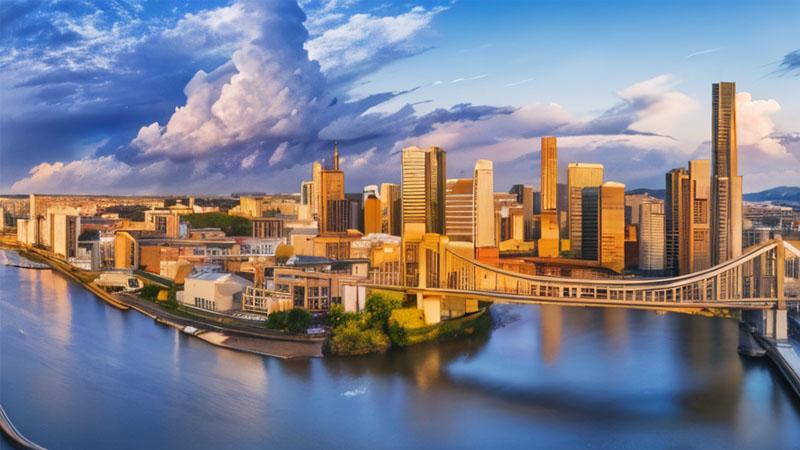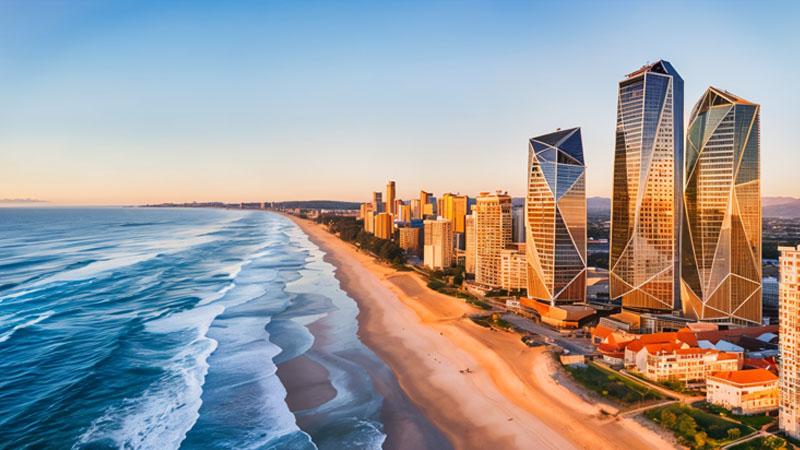New South Wales
Sydney
Sydney, the capital of New South Wales and Australia's largest city, is best known for its harbourfront Sydney Opera House, with a distinctive sail-like design. Massive Darling Harbour and the smaller Circular Quay (pronounced “key”) port are hubs of waterside life, with the arched Harbour Bridge and esteemed Royal Botanic Garden nearby. Sydney Tower’s outdoor platform, the Skywalk, offers 360-degree views of the city and suburbs.
Although the land has been cared for and lived in for thousands of years by Indigenous Australians. Sydney was first visited by the British in 1770 when Captain James Cook and Joseph Banks sailed the Endeavour into Botany Bay. The First Fleet arrived at Botany Bay in 1788 under the command of Governor Arthur Phillip.
Sydney has many cultural influences. Aboriginal sites and engravings are still present from the traditional land owners, the Eora tribe. The city also has an Anglo Mediterranean style with growing Chinese and Asian influences.
The Sydney Harbor Bridge both divides and connects the city into two parts: North and South. Most of the tourist attractions are on the south side of the bridge, with a large business and residential areas on the north side. The South part of the city consists of The Rocks and Circular Quay, and Luna Park on the North side. Also on the South side, Darling Harbour marks the West, and there are a number of parks and beaches to the East.
Sydney offers a whole range of great tourist attractions from the world-famous Sydney Opera House and Sydney Harbour Bridge to the sandy shores of Bondi Beach.
Blue Mountains
Home to some of the country’s most beautiful natural attractions, the Blue Mountains are less than 2 hours away from Sydney by car or train. Deep valley troughs that have been formed over millions of years offer sensational views, some of the lookouts located at Wentworth Falls, Govetts Leap and Echo Point.
Remember not to miss the superb views of the Three Sisters and beyond once you reach Katoomba. Here you can also experience Scenic World, where the glass-topped carriage of the Scenic Railway take you on a heart-stopping ride into the depths of the Jamison Valley, or jump abroad the Scenic Skyway and journey high over the canyon for amazing views.
Northern Beaches
The beautiful coastline runs from Manly to Palm Beach, a popular destination for fans of TV soap Home and Away. A very casual and sporty lifestyle plus the natural beauty of the area, makes the Northern Beaches one the most famous surfing meccas of Australia. Also popular for great variety of places to eat and drink with friends and family.
If wanting to learn how to dive, surf or swim, Manly Beach offers all of it with popular schools such as Manly Surf School and Manly Surf Guide.
Bondi Beach
Bondi is world renowned and even if you haven’t visited yet, chances are you’ve heard of it; and once you get there you will know why it deserves its reputation. The expansive soft, white sand, the crashing waves and sand cliffs all unite to manifest a spectacular seaside suburb that offers something for everyone.
Bondi is patrolled by professional lifesavers and is also home to one of the oldest surf lifesaving clubs in the world and one of Australia’s oldest swimming clubs, the Bondi Icebergs.
There is a memorable coastal walk from Bondi to Coogee, a 6km trail that has been carved into sandstone cliffs and offers uninterrupted views of the ocean.
Victoria
Melbourne
Melbourne, the capital of the state of Victoria, has a population of more than three million, making it Australia's second largest city. It is regarded as the cultural and fashion capital of Australia and renowned for its fine restaurants. It is a true multicultural city with more than one quarter of Melbourne's residents born overseas. Although the official language spoken in Melbourne is English, hundreds of languages are spoken by residents including Mandarin, Italian, Spanish, Greek, Cantonese, Arabic and Vietnamese.
It was the gold rush of the 1850s that truly put Melbourne on the map as a global city, transforming it into one of the richest and largest cities in the world in a matter of years. That rapid growth and affluence helped Melbourne grow into the city it is today – ranked the most liveable city in the world 5 years in a row and one of the top 30 cities in the world in the Global Financial Centres Index. From the Melbourne Cricket Ground to the National Gallery of Victoria, it is home to some of the country’s most iconic sites.
Yarra Valley & Dandenong Ranges
Take an early morning balloon flight, meet passionate food and wine producers, and encounter a platypus at Healesville Sanctuary in the Yarra Valley. Wander the walking trails, meander the villages and discover the hidden delights of the Dandenong Ranges among its scenic winding roads, abundant artist studios, craft stores and renowned gardens. There is something for everyone at this beautiful part of Victoria.
The Mornington Peninsula
Take a trip down the Mornington Peninsula and be dazzled by the vibrant coastal villages and charming hinterland hamlets full of boutique wineries and acclaimed restaurants, art galleries, manicured gardens, geothermal springs and renowned golf courses. Pass the famous, quaint and colourful bathing boxes strung along the beachfronts of Dromana, Rosebud and Mornington, and then head inland through the rolling hills and its amazing views.
Discover life on and underwater around Mornington Peninsula's beautiful sandy beaches. Catch a wave at surf beaches, scuba dive around the Portsea pier reef system, encounter stunning sea dragons as you snorkel the underwater trail around Rye pier, and frolic with the seals and dolphins in the waters off Sorrento
Phillip Island
Pristine white beaches and hi-octane motor sports, endless options for fun and discovery of its iconic wildlife. Visitors find it all on a seaside holiday at Phillip Island, just 90 minutes from Melbourne. See little penguins and sleepy koalas in their natural habitat, swim on a quiet bay beach, and soak up all the action at the Australian Motorcycle Grand Prix.
Great Ocean Road
See the towering 12 Apostles, get up close to native wildlife, and take in iconic surf breaks, pristine rainforest and misty waterfalls along the spectacular Great Ocean Road. Get outdoors on bushwalking, surfing and mountain biking expeditions or take the cultural route through galleries, museums and heritage attractions. Feast on spectacular views and local produce along the way.
Queensland

Brisbane
Brisbane is the capital of Queensland and the third-largest city in Australia, with a population of over 2.7 million. It is located on the Brisbane River and is known for its vibrant urban precincts, outdoor lifestyle, and friendly locals.
Brisbane has several popular areas that are well-loved by both locals and visitors:
South Bank
A cultural and recreational precinct with parklands, restaurants, and the iconic Wheel of Brisbane.
Fortitude Valley
It is known for its nightlife, live music venues, and diverse dining options.
New Farm
A trendy suburb with the popular New Farm Park and the Brisbane Powerhouse, a hub for arts and culture.
West End
A bohemian area with eclectic cafes, markets, and a strong community vibe.
Kangaroo Point
It offers stunning views of the city skyline and is a popular spot for rock climbing and picnics.
Gold Coast
Gold Coast
Gold Coast is a coastal city located approximately 66 kilometres south-southeast of Brisbane. It is Queensland's second-largest city and a major tourist destination known for its stunning beaches, theme parks, and vibrant nightlife.
Gold Coast has several popular areas that are well-loved by both locals and visitors:
Surfers Paradise
Famous for its high-rise skyline, shopping, dining, and nightlife, as well as its beautiful beach.
Broadbeach
Known for its upscale dining, shopping at Pacific Fair, and the Gold Coast Convention and Exhibition Centre.
Southport
The central business district of the Gold Coast, offering shopping, dining, and the Broadwater Parklands.
Burleigh Heads
A laid-back suburb with a beautiful beach, national park, and a thriving café culture.
Coolangatta
Located near the Queensland-New South Wales border, known for its relaxed atmosphere and excellent surfing beaches.




